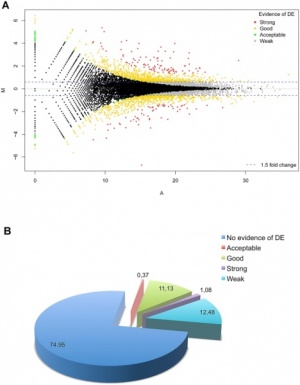User:Z3289829
Lab 4 Online Assessment
- The allantois, identified in the placental cord, is continuous with what anatomical structure?
- Identify the 3 vascular shunts, and their location, in the embryonic circulation.
- Identify the Group project sub-section that you will be researching. (Add to project page and your individual assessment page)
--Mark Hill 09:38, 3 August 2011 (EST) All 3 questions from Lab 1 need to be completed before Lab 2.
Class Attendance
--Z3289829 12:56, 28 July 2011 (EST)
--Z3289829 12:53, 4 August 2011 (EST)
--z3289829 12:21, 11 August 2011 (EST)
--z3289829 11:52, 18 August 2011 (EST)
--z3289829 11:07, 25 August 2011 (EST)
--z3289829 11:37, 1 September 2011 (EST)
Laboratory Assignments
Lab Assessment I
1. Identify the origin of In Vitro Fertilisation and the 2010 Nobel Prize winner associated with this technique.
- The first pregnancy achieved through in vitro human fertilisation of a human oocyte was reported in the Lancet from the Monash university in 1973, although it only lasted a few days. The first successful IVF was carried out in the UK in 1978 by Robert G. Edwards, later awarded the Nobel Prize in Medicine “for the development of in vitro fertilisation” in 2010.
2. Identify a recent paper on fertilisation and describe its key findings.
- Lisa Moran et al. (2011) assessed the effect of a high-protein weight-loss program with exercise pre- assisted reproductive technology (ART) treatment on pregnancy and live birth outcomes in overweight and obese women. The high-protein weight-loss diet resulted in a significantly reduced weight compared with no treatment. A reduction in waist circumference was associated with increased chances of pregnancy. The overall pregnancy rate was 53% for the intervention and control group combined (compared with the expected spontaneous pregnancy rates of <10% per month in this population). These results established the efficacy of lifestyle treatment for overweight women in ART.[1]
3. Identify 2 congenital anomalies.
- Trisomy 21 (Down Syndrome) & Trisomy 18 (Edward Syndrome)
Lab Assessment II
1. Identify the ZP protein that spermatozoa binds and how is this changed (altered) after fertilisation.
- The zona pellucida is an extracellular matrix that surrounds the oocyte and early embryo. It is composed primarily of three to four glycoproteins which have various functions in fertilisation. The protein encoded by zona pellucida glycoprotein 3 (ZP3) is the primary spermatozoa receptor during fertilisation. The binding of ZP3 to sperm activates a range of intracellular signal cascades, which culminate in fusion of the plasma membrane and underlying outer acrosomal membrane (i.e. the acrosome reaction). Fusion of the sperm with the oocyte triggers a release of calcium ions, which results in depolarisation of the oocyte plasma membrane, by which fusion of another sperm is prevented. The rapid depolarisation provides an early block to polyspermy and is mediated by the cortical reaction.
2. Identify a review and a research article related to your group topic. (Paste on both group discussion page with signature and on your own page)
Review Article: Klinefelter Syndrome [1]
Research Article: Klinefelter's syndrome (XXY) as a genetic model for psychotic disorders [2]
Class exercise: Upload Sample Image
Lab Assessment III
1.What is the maternal dietary requirement for late neural development?
- Iodine is essential for the synthesis of thyroid hormones, thyroxine (T4) and triiodothyronine (T3). These hormones act by regulating the metabolic pattern of most cells and play an important role in the process of early growth and development of the brain. Iodine deficiency during pregnancy leading to hyperthyroidism in the foetus results in cretinism, characterised by severe mental retardation. Therefore supplements of iodine can prevent these abnormalities if taken before conception and during the first two months of pregnancy.[2]
2. Upload a picture relating to you group project.
Lab Assessment IV
1. The allantois, identified in the placental cord, is continuous with what anatomical structure?
- The allantois is a sac-like structure which appears on approximately day 16 from the caudal wall of the umbilical vesicle that extends into the connecting stalk. During folding, the terminal part of the hind gut dilates to form the cloaca, which is primordial for the urinary bladder and rectum. The allantois is carried backwards in folding and is continuous with the cloaca region of the hind gut.
2. Identify the 3 vascular shunts, and their location, in the embryonic circulation.
- - Ductus arteriosis: connects the left pulmonary artery and the descending aorta
- - Ductus venosus: connects the portal and umbilical veins to the inferior vena cava
- - Foramen ovale: connects the right and left atrium
3. Identify the Group project sub-section that you will be researching.
- History (with an included timeline), Aetiology and a case study
Lab Assessment V
1. Which side (L/R) is most common for diaphragmatic hernia and why?
- Congenital diaphragmatic hernia occurs on the left side in 85% to 90% of cases. The predominance of left-sided may be related to the earlier closure of the right pleuroperitoneal opening.
Lab Assessment VI
1. What week of development do the palatal shelves fuse?
- The primary palates in the human embryo fuse between stage 17 and 18, from an epithelial seam to the mesenchymal bridge. The secondary palate, fuse in week 9 in the human embryo. The fusion of the secondary palate requires the early palatal shelves growth, elevation and fusion during the early embryonic period. The fusion incorporates both secondary palates and the primary palate.
2. What early animal model helped elucidate the neural crest origin and migration of neural crest cells?
- The chicken/quail chimera’s model undertaken by LeDouarin in the 1980s was a key experiment in the understanding of the pattern of neural crest migration. It was a transplantation and histological processing to identify the migration path and final destination of transplanted neural crest cells.
3. What abnormality results from neural crest not migrating into the cardiac outflow tract?
- Tetralogy of Fallot, is the cardiac abnormality which may occur from abnormal neural crest migration.

